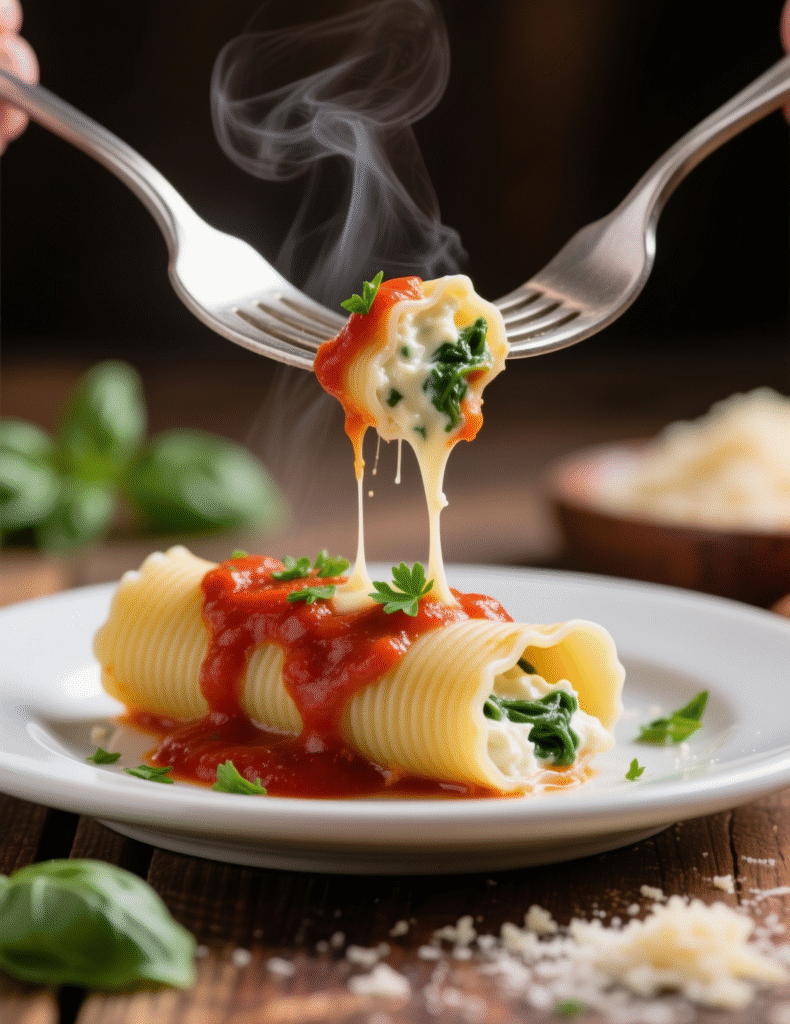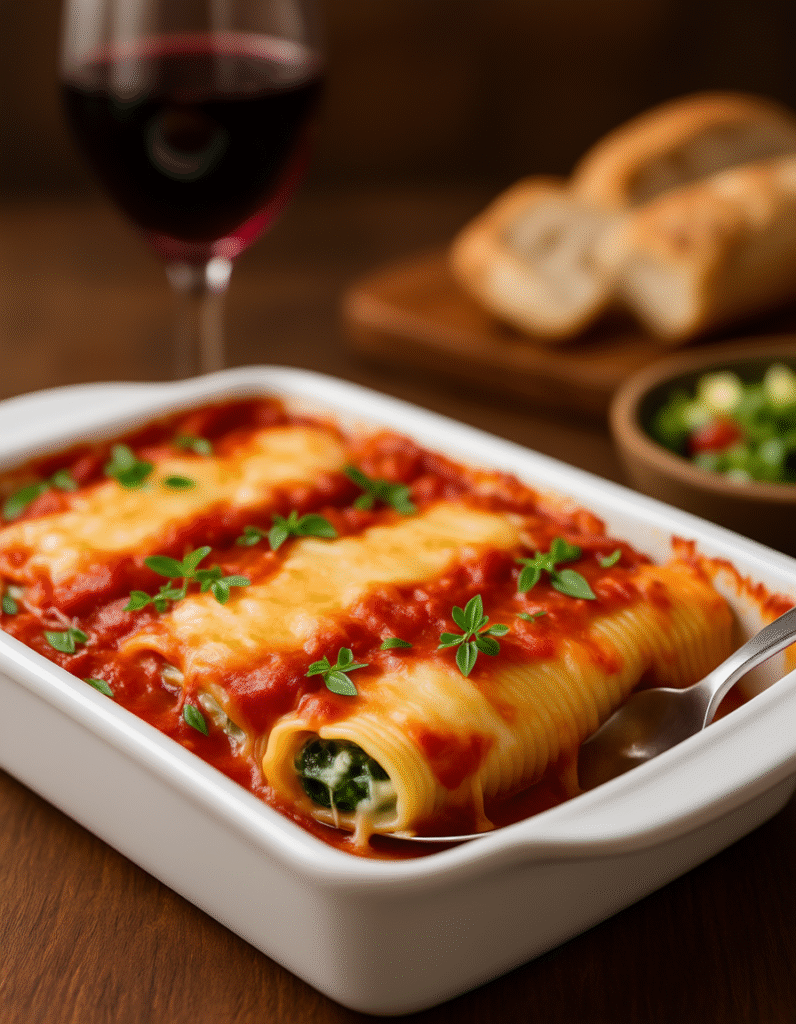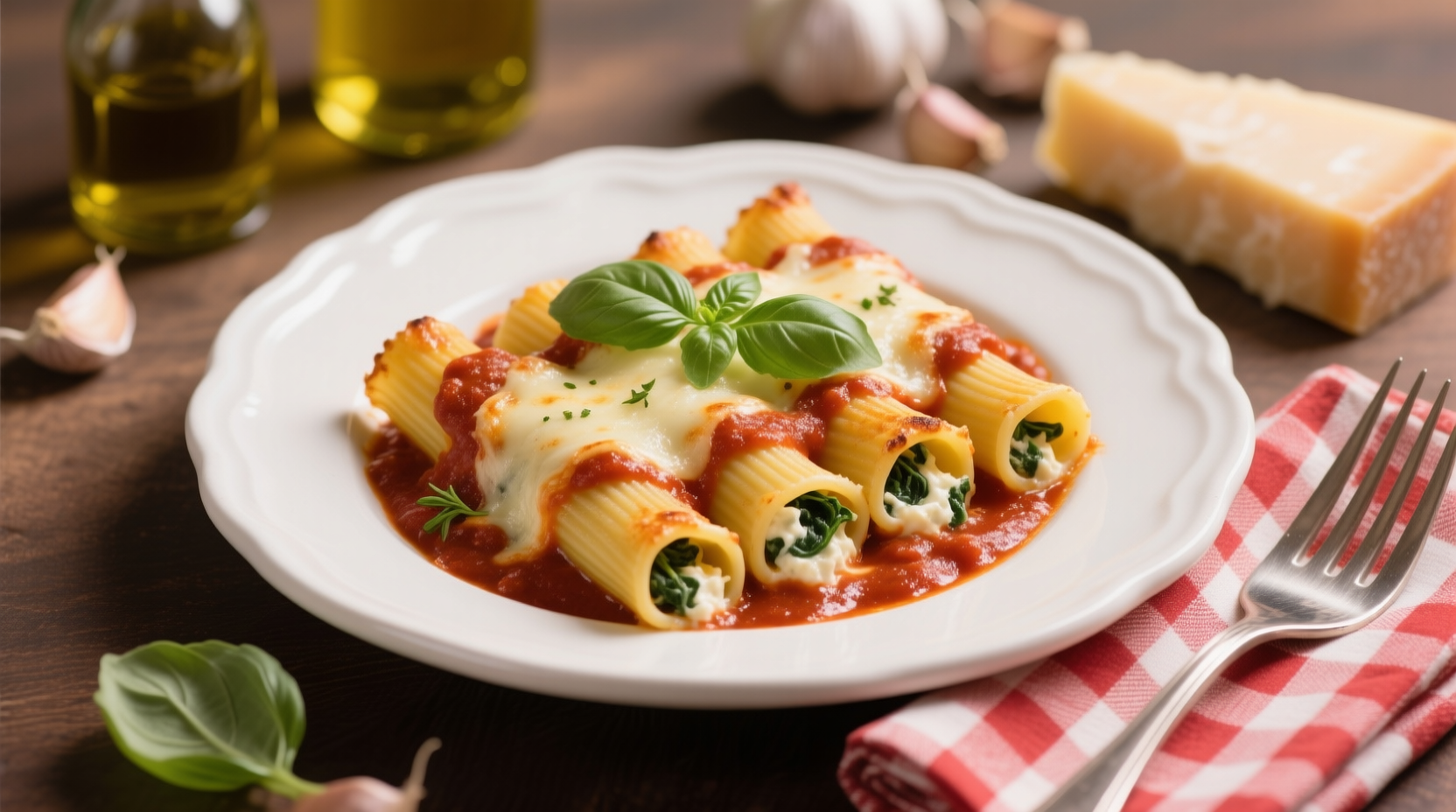Stuffed manicotti isn’t just pasta filled with cheese and sauce. It’s a quiet conversation between ingredients, a dish that demands patience and rewards it with warmth that lingers. Professionals in kitchens know—it’s not about following a recipe blindly, it’s about understanding why the pasta must be cooked just-so, why ricotta matters, why sauce needs depth, not just sweetness. That’s the real craft.
Understanding Manicotti at Its Core
Manicotti, meaning “little sleeves” in Italian, are large pasta tubes designed to be filled. The filling can range from ricotta and spinach to slow-braised meats. In authentic Italian-American kitchens, it’s almost always a family Sunday dish, cooked in trays, layered with sauce, and baked until bubbling.
Chefs often debate the pasta itself. Dried manicotti tubes are widely sold, but they’re thick and prone to splitting when overfilled. Fresh pasta sheets, rolled and shaped into cylinders, cook more evenly and absorb sauce better. That small choice changes the final dish more than most casual cooks realize.
The Role of Cheese in the Filling
Ricotta is the backbone of the filling. But not all ricotta is equal. Industrial ricotta is often grainy and watery, which ruins texture. Professional kitchens will either make ricotta in-house (from whey or whole milk acidified with vinegar) or buy from specialty dairies. The goal is creaminess with a clean milk flavor.
Mozzarella is essential for stretch. Professionals usually use low-moisture mozzarella grated fine so it doesn’t release excess water. Parmesan or pecorino romano adds salinity and sharpness. Without aged cheese, the filling becomes flat, almost cloying. A blend is always superior to just one cheese.
Pasta Preparation: Cooking Without Ruin
One of the biggest errors cooks make is overcooking the manicotti shells. Dried tubes need parboiling—about 4 to 5 minutes only. They should be flexible but still firm. A fully cooked tube tears the moment you try to pipe filling inside.
Some chefs avoid boiling altogether. They stuff raw pasta shells and let the sauce bake them soft. This works if you have a generous sauce that stays loose during baking. Too little sauce? You’ll end with leathery pasta edges that crunch instead of yielding.
Sauce: More Than Just Red
A manicotti is only as good as the sauce it swims in. Most recipes default to marinara, but professionals go deeper. A long-simmered tomato sauce—cooked for at least 2 hours with onion, garlic, basil, and sometimes pork bones—adds layers of flavor. It’s not just tomatoes and salt.
White béchamel can also be used. In Northern Italy, manicotti or cannelloni sometimes get filled with spinach and ricotta and covered in béchamel instead of tomato. It’s creamy, delicate, and highlights the filling instead of competing with it.
In modern kitchens, chefs experiment with roasted red pepper sauces or even light broths infused with herbs. The rule? Sauce should carry the pasta, not smother it.

Filling Techniques Professionals Rely On
You can fill manicotti with a spoon, but it’s messy. The professional method is piping bags fitted with wide tips. Ricotta filling pipes smoothly into parboiled tubes, evenly distributing without breaking pasta.
For added stability, chefs often fold in one whole egg per 2 cups of ricotta. The egg binds filling as it bakes, giving structure. Without it, the cheese might ooze out in puddles.
Spinach is another classic add-in. It must be blanched, shocked, squeezed bone-dry, and chopped finely. Any extra water turns the filling soupy. Small misstep, big consequences.
Layering and Baking
In assembly, sauce goes first in the baking dish. Dry pasta against dry ceramic burns and sticks, so sauce creates the cushion. Then manicotti, snug but not crowded. More sauce, then cheese sprinkled lightly.
Covering with foil for the first half of baking prevents drying. Removing foil near the end allows cheese topping to brown. Professionals bake manicotti at 375°F (190°C) for about 30 to 35 minutes. The balance is ensuring the filling sets while the pasta finishes cooking.
Variations Worth Exploring
Though ricotta-spinach is traditional, chefs have innovated wildly.
- Meat filling: Ground veal, pork, and beef mixed with herbs makes a heartier filling.
- Seafood manicotti: Lobster or crab folded into mascarpone, finished with a light cream sauce.
- Vegetable-forward: Roasted butternut squash with sage and ricotta.
- Modern twists: Goat cheese with caramelized onions, or truffle oil-infused ricotta.
These aren’t gimmicks; they reflect how manicotti adapts across kitchens while still honoring the core idea: pasta as a vessel.
Addressing Common Misconceptions
Many home cooks think more cheese equals better manicotti. In truth, restraint makes it better. Too much mozzarella leads to greasy puddles. Too much ricotta without egg leads to collapse. Balance always wins.
Another misconception is sauce quantity. Flooding manicotti with sauce doesn’t improve it. Pasta should still shine. Professionals layer modestly—enough to coat, not drown.
Finally, some believe manicotti is identical to cannelloni. They are cousins but not twins. Manicotti usually refers to ridged, tubular pasta sold dried in boxes in the U.S. Cannelloni is typically fresh pasta rolled into tubes. Technique shifts with pasta style.
Trends in Professional Kitchens
Today’s chefs are rethinking manicotti plating. Instead of casserole trays, some serve individual portions—two manicotti plated with microgreens, reduced tomato jus drizzled instead of ladled. Fine dining makes manicotti elegant, not just comforting.
Plant-based versions are also rising. Tofu blended with cashew cream replaces ricotta, giving vegan manicotti structure. Gluten-free manicotti shells, made from rice flour, are appearing in specialty stores. Demand for inclusivity in dining drives these innovations.
Statistics show growth too. According to the Specialty Food Association, Italian-American pasta bakes like manicotti see rising sales in frozen and prepared foods markets, especially among millennial buyers seeking nostalgia.

Expert Tips for Perfect Execution
- Always taste ricotta filling raw before stuffing. Seasoning gets muted during baking.
- Use a ladle of sauce under the manicotti to prevent sticking.
- Don’t skip resting time. Let baked manicotti sit for 10 minutes before cutting. It sets filling and prevents collapse.
- For catering, manicotti holds well in hot boxes if sauce volume is controlled. Professionals under-sauce slightly, then refresh with extra ladle of hot sauce before serving.
A Professional Recipe
Ingredients (Serves 6–8)
- 12 manicotti shells
- 2 cups whole milk ricotta, well-drained
- 1 cup shredded mozzarella, low moisture
- ½ cup grated parmesan
- 1 egg
- 1 cup cooked spinach, squeezed dry, chopped
- 3 cups tomato sauce (simmered, seasoned deeply)
- 2 tbsp olive oil
- Fresh basil for garnish
- Salt and black pepper to taste
Method
- Parboil shells for 5 minutes, drain, and cool on oiled sheet.
- Mix ricotta, mozzarella, parmesan, egg, spinach, salt, pepper. Taste and adjust seasoning.
- Transfer filling to piping bag. Pipe evenly into each shell.
- In baking dish, spread sauce. Lay manicotti snugly. Cover with more sauce.
- Sprinkle mozzarella and parmesan lightly.
- Cover with foil, bake 20 minutes at 375°F. Remove foil, bake 10–15 minutes until bubbling and browned.
- Rest 10 minutes, garnish with basil, serve.
Why This Dish Endures
Stuffed manicotti holds power because it feels both humble and grand. It’s pasta, cheese, sauce—the simplest ingredients turned into something layered and soulful. Professionals respect it because it teaches patience and control. Every step, from boiling shells to balancing cheese ratios, demands intention.
For diners, manicotti is more than dinner. It’s family table food, shared, cut into portions, passed along. And maybe that’s why chefs keep returning to it—not just for its flavor, but for its ability to connect people.
Conclusion
Mastering stuffed manicotti isn’t about memorizing a recipe. It’s about respecting ingredients, controlling technique, and knowing when to push tradition and when to honor it. Chefs who understand ricotta texture, pasta handling, and sauce depth will always produce better results than those chasing shortcuts.
For professionals, this dish offers lessons in balance, restraint, and care. For everyone else, it offers comfort. And comfort done right is one of the hardest things to perfect in cooking.
FAQs
What is the difference between manicotti and cannelloni?
Manicotti are ridged pasta tubes, while cannelloni are usually smooth pasta sheets rolled into cylinders.
Can I make manicotti ahead of time?
Yes, you can assemble it a day before, cover, refrigerate, and bake when needed.
Do I need to boil manicotti shells before stuffing?
Parboiling is recommended for dried shells, though some no-boil methods work with extra sauce.
What cheeses are best for manicotti filling?
Ricotta, mozzarella, and parmesan (or pecorino) make the ideal balanced filling.
Why is my manicotti watery after baking?
Usually because of watery ricotta or spinach not being drained properly.
Can manicotti be frozen?
Yes, you can freeze unbaked manicotti and bake directly from frozen with added cooking time.
How long should manicotti bake?
Typically 30–35 minutes at 375°F, covered first then uncovered to brown.
What sauce works best with stuffed manicotti?
A slow-simmered tomato sauce is traditional, but béchamel or cream sauces also work well.
Can manicotti be vegetarian?
Yes, ricotta-spinach or vegetable fillings are common and flavorful vegetarian options.
How do professionals fill manicotti neatly?
They use a piping bag for even, mess-free filling without breaking pasta tubes.

Mariana is a passionate home cook who creates delicious, easy-to-follow recipes for busy people. From energizing breakfasts to satisfying dinners and indulgent desserts, her dishes are designed to fuel both your body and hustle.
When she’s not in the kitchen, she’s exploring new flavors and dreaming up her next recipe to share with the Foodie Hustle community.

